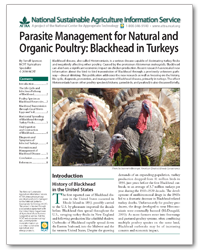Parasite Management for Natural and Organic Poultry: Blackhead in Turkeys
By Terrell Spencer, NCAT Sustainable Agriculture Specialist
Abstract
Blackhead disease, also called Histomoniasis, is a serious disease capable of decimating turkey flocks and negatively affecting other poultry. Caused by the protozoan Histomonas meleagridis, Blackhead can also have a significant economic impact on chicken production. Recent research has revealed new information about the bird-to-bird transmission of Blackhead through a previously unknown pathway — cloacal drinking. This publication addresses the new research as well as focusing on the history, life cycle, diagnosis, prevention, and management of Blackhead disease, primarily in turkeys. The effect Histomoniasis has on other poultry species (chickens, gamebirds, and peafowl) is also discussed briefly.
Contents
Introduction
The Life Cycle and Infectious Pathway of Blackhead
Poultry Species as Blackhead Reservoirs
Blackhead Transmission Through Cecal Worm Eggs and Soil
Horizontal Spreading of Blackhead through Turkey Flocks
Oral Ingestion and Contraction of Blackhead
Diagnosis and Symptoms of Infected Turkeys
Prevention and Management of Blackhead Disease
Conclusion
References
Introduction
History of Blackhead in the United States
The first reported case of Blackhead disease in the United States occurred in Rhode Island in 1893, possibly carried to the United States by pheasants imported the decade before. Blackhead then spread throughout the United States, ravaging turkey flocks in New England and following production like a faithful shadow. Outbreaks of Blackhead rapidly spread down the Eastern Seaboard, into the Midwest and the far western United States. Despite the growing demands of an expanding population, turkey production dropped from 11 million birds in 1890, just years before the first Blackhead outbreak, to an average of 3.7 million turkeys per year during the 1910-1920 decade. The development of antihistomonal drugs in the 1960s led to a dramatic decrease in Blackhead-related turkey deaths. Unfortunately for poultry producers, the drugs developed to treat Histomoniasis were eventually banned (McDougald, 2005). As more farmers enter into free-range and pastured-poultry systems, often combining multiple poultry species on the same land, Blackhead outbreaks may be of increasing concern and economic impact.
The Life Cycle and Infectious Pathway of Blackhead
Blackhead occurs when the causal agent, the protozoan Histomonas meleagridis, gains access to the ceca, or blind pouches of the intestines. Blackhead infects poultry using three separate pathways that will be examined in detail in this publication:
- Ingestion of soil or earthworms containing eggs of the cecal worm Heterakis gallinarum, infected with H. meleagridis
- Uptake of H. meleagridis directly into the lower digestive tract through the process of “cloacal drinking”
- Oral ingestion of live H. meleagridis protozoa when stomach is not acidic enough to kill the pathogen
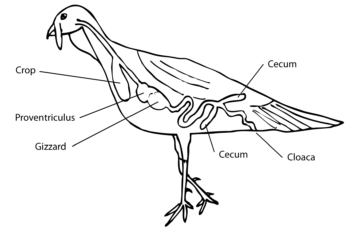
Figure 1. Turkey Digestive Tract. Illustration: Terrell Spencer, NCAT
Once access into the digestive tract has been achieved, H. meleagridis multiplies in the ceca and attacks the tissues of the cecal walls. As the disease progresses, a cheese-like, foul-smelling, yellow substance fills the ceca. This substance can vary in form from a hardened plug to more liquid in nature, and is composed of dead cecal cells and blood. In highly susceptible birds such as turkeys, the Blackhead protozoa then enter the bloodstream through the damaged ceca and are deposited into the liver, where they do even more damage, creating signature “bulls-eye” zones of necrosis (dead tissue). Occasionally, H. meleagridis also enters into other organs such as the kidneys, lungs, heart, and brain. Blackhead does not kill the infected bird, and the disease requires a secondary bacterial infection to be virulent and eventually fatal. Escherichia coli, Bacillus subtilis, and Clostridium sp. are some of the bacteria noted in the secondary infections that caused death (McDougald, 2005).
Poultry Species as Blackhead Reservoirs
Among poultry species, there are varying degrees of susceptibility to Blackhead. Some birds, such as pheasants, ducks, and geese, are nearly immune to the effects of Blackhead. Chickens are somewhat resistant to the disease, while turkeys and peafowl are extremely vulnerable and have high mortality rates when infected with H. meleagridis. Experiments have shown that infected pheasants and chickens are capable of transmitting Blackhead to young turkeys (Lund and Chute, 1972).
Traditional wisdom dictating that chickens and turkeys not be raised together is most likely based on experience with Histomoniasis. Chickens are excellent hosts for the cecal worm that H. meleagridis uses as a vector. It is not unreasonable to assume that the majority of Blackhead outbreaks, especially among small, diversified farmers, can be traced back to chickens.
Among chickens, laying hens and breeding roosters have the potential to shed many more cecal worm eggs than broilers due to age differences in production — a broiler is usually slaughtered at six to 12 weeks (six to eight weeks for Cornish cross; 12 or more weeks for slower-growing breeds), while a hen may be kept for two or more years. The cecal worm in question, H. gallinarum, takes approximately a month to mature and begin shedding eggs. This time frame, coupled with the two to four weeks chicks spend in the brooder, allows little to no time for a broiler to contaminate the soil with cecal worm eggs. On the other hand, a hen in production for several years can seed tremendous amounts of cecal worm eggs into the soil during her lifetime.
Blackhead Transmission through Cecal Worm Eggs and Soil
The indirect ingestion of Blackhead protozoa through consumption of earthworms and cecal worm eggs is the most commonly known means of contracting Histomoniasis. When exposed to the elements, the Blackhead pathogen is short-lived, being highly susceptible to environmental stresses — sunlight, wind, and temperature extremes. H. meleagridis has overcome this limitation through infecting cecal worm eggs, as these eggs are extremely hardy. The eggs can remain viable up to three years in the soil; in addition, cecal worms are very common in many poultry species, especially chickens. Contaminated cecal worm eggs are consumed when birds ingest soil either intentionally or during foraging. Earthworms also act as an intermediate vehicle for spreading the disease, as the earthworms consume soil containing the infected cecal worm eggs. The earthworms, in turn, are readily consumed by all types of poultry.

Figure 2. Blackhead life cycle. By Terrell Spencer, NCAT
Horizontal Spreading of Blackhead through Turkey Flocks
The contraction of Blackhead disease by turkeys has traditionally been attributed solely to the vectoring of the disease through cecal worm eggs and earthworms. However, recent research has shown that turkeys can infect other members of the flock directly through a process known as cloacal drinking (Hu et al., 2004, McDougald and Fuller, 2005).
| Cloacal drinking is the reflexive intake of fluids through the cloaca in order to inoculate the young bird’s immune system with the microbial flora of the surrounding environment. |
Unfortunately for both the turkey and the farmer, the turkey immune system has little to no defense against Blackhead, and the Blackhead protozoans that enter through the cloaca multiply unrestricted. Uptake of H. meleagridis through the cloaca occurs when a turkey’s cloaca comes into contact with contaminated fecal matter, most likely while resting. The pathogenic protozoa are then drawn into the digestive tract through the cloacal drinking process and migrate to the ceca, where infection occurs.
Historically, contraction of Blackhead through cecal worm eggs has explained the beginning of outbreaks in poultry flocks, but failed to account for the rapidity with which Blackhead spreads throughout the flock. The lack of an explanation for the continued transmission of Histomoniasis through a flock, despite the exclusion of earthworms and soil containing cecal worm eggs, has been a source of frustration and setback for farmers. Now, thanks to recent research findings, this gap in the basic understanding of the Blackhead lifecycle has been closed.
Oral Ingestion and Contraction of Blackhead
When the turkey is given a constant supply of food, experiments have suggested that H. meleagridis ingested orally is not capable of surviving the passage through the stomach — more specifically, the proventriculus — due to the stomach acids produced. Therefore, Blackhead is typically not transmitted orally (Hu et al., 2004). When a turkey feeds, acid is produced to aid in digestion, and this acidification destroys H. meleagridis. After six hours of not feeding, however, the lack of stomach acid allows the turkey’s gastrointestinal tract to go from being acidic to neutral in pH, and this change can allow H. meleagridis to survive oral ingestion (McDougald, 2005).
Diagnosis and Symptoms of Infected Turkeys
Physical Symptoms of Blackhead
- Mustardy, yellowish colored stool — varies from a watery, foamy diarrhea to a dry, solid black stool with waxy yellowish streaks
- Bulls-eye-shaped necrotic pitting on liver
- Ceca filled with yellow, cheesy substance
Behavioral Signs of Blackhead
- Lethargy
- Drooping wings
- Dry, ruffled feathers
- Suppressed appetite, increased thirst
- Decreased/lack of flight distance (distance the turkey keeps between itself and humans)
- Decreased/lack of inquisitiveness
Blackhead infections vary in the time required to manifest signs, depending on the pathway and initial amount of infection. Signs of infection begin to appear seven to 14 days after exposure. In turkeys, the yellow-colored fecal matter is the definitive symptom of Blackhead disease. From personal experience, when behavioral symptoms become apparent, mortality usually occurs in one to three days.
Positive diagnosis of dead birds can be easily obtained through a post-mortem dissection (necropsy) by the farmer. The abdominal cavity can be opened and the cecum examined. The chest/breast can then be split down the middle using heavy duty shears or tin snips to reveal the liver. Once the ceca and liver are exposed, the organs can be inspected for necrosis as described above.
Despite the descriptive name of the disease, Blackhead rarely, if ever, causes the head of the infected bird to darken or turn black, so the common name is somewhat of a misnomer (Davidson and Doster, 2010).
Turkeys demonstrate the most severe symptoms of any poultry from H. meleagridis infection and, consequently, the highest mortality rates. Indeed, expectations of 80 to 100% mortality are plausible in turkey Blackhead outbreaks. Chickens are usually able to stop the disease before destruction of the ceca and degradation of the liver take place. Infections in chickens often are undiagnosed, though in chickens the impact of Blackhead has been described as being at least as severe as coccidiosis, and in some broiler breeder flocks, mortality may reach as high as 10% (McDougald, 2005). Bobwhite quail farmers have also occasionally experienced outbreaks of Blackhead disease, especially when these growers utilize old chicken houses.

An ill turkey showing classic signs of sickness: lethargy (as seen by the closed eyes), lack of inquisitiveness, retracted neck, and drooping wings. Photo by Terrell Spencer, NCAT |
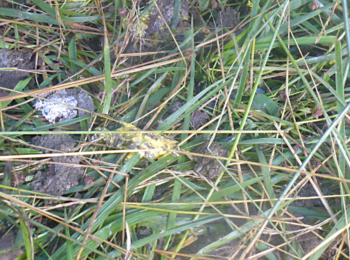
Regular (on left) and Blackhead-infected (right) turkey droppings. The tell-tale sulfur colored droppings indicative of a Blackhead infection are clear. Photo by Terrell Spencer, NCAT |

On farm dissection showing characteristic liver necrosis due to Blackhead. Photo by Terrell Spencer, NCAT |
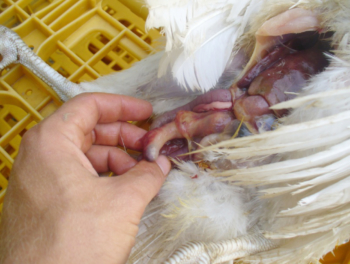
Enlarged cecum filled with yellowish necrotic tissue in a Blackhead-infected turkey. Photo by Terrell Spencer, NCAT |
Prevention and Management of Blackhead Disease
Prevention is the key to successful Blackhead management. Due to the previously mentioned banning of the antihistomonal medicines used to treat outbreaks, there are no established treatments for turkeys once they are infected and symptomatic. It is imperative that any truly sustainable turkey operation have a Blackhead prevention plan.
Preventative and Post-Infection Measures
The most economical and sustainable method of Blackhead management is complete avoidance of the disease through preventive treatments.
- Separation of poultry flocks by species and age — separation of susceptible (turkeys and peafowl) and resistant (chickens, pheasants, quail, etc.) poultry species has been the principal means of Histomoniasis prevention since the cecal worm role in disease transmission was identified in the 1930s. Separation should also include ground that has been used for different poultry species. Land that has been used to house/pasture chickens or gamebirds should not be used for turkeys or peafowl production.
- Fallowing of contaminated ground or houses — Cecal worm eggs are viable up to three years in the soil and litter, and research has shown that H. meleagridis harbored inside of the eggs remains infectious even after 150 weeks. Therefore, three years should be the minimum time considered for fallowing.
- Selecting for resistance — while this strategy is not plausible for Broadbreasted Whites, heritage turkeys can be selected for resistance to Blackhead. If a Blackhead outbreak occurs in a heritage flock, the surviving individuals may have some trait, either genetic or behavioral, that increases their chance of surviving or avoiding a Blackhead infection. These birds could be saved and bred to obtain next season’s poults, and at least some resistance to Blackhead could be bred into a producer’s flock.
- Preventative feed additives:
- Histostat™ (active ingredient is Nitarsone) is an effective preventative feed additive and can be premixed into feed. It is a non-organic additive that contains arsenic and is the only drug approved for the prevention of Blackhead. At the time of this writing, Blue Seal Feeds™, located in the Northeastern and Mid-Atlantic regions of the United States, sells a pre-mixed medicated turkey feed containing Histostat.Other than within the Blue Seal product, the use of Histostat is difficult at best for a small producer. The drug is only sold in 55-pound bags — enough Histostat to mix more than 65 tons of feed. Additionally, the drug can only be purchased by registered feed mills, and Histostat must be mixed into the ration as the feed is milled. Finally, at approximately $15 per pound, Histostat is a costly drug to buy in bulk. Histostat cannot be fed to actively producing layers and has a short withdrawal period (five days) to allow the arsenic ingested by the bird to be flushed from the system. In addition, Histostat is toxic to dogs, ruminants, and waterfowl. The toxicity to other species is an additional burden to mills that must thoroughly clean their feed machinery before mixing non-poultry feeds.
- Natustat™ is a plant-based additive manufactured by Alltech, Inc. that, just like Histostat, is mixed into the ration when the feed is milled. Natustat promotes poultry well-being and discourages Blackhead by acting as an immune system booster that stimulates good health. The company’s research trials have shown that it is comparable to Histostat in the prevention of Blackhead when birds are exposed to infected litter, but it is not effective in preventing Blackhead when poultry are exposed to the parasite directly (as through cloacal drinking).Natustat is available to small growers directly in 55-pound bags. During the summer of 2010, the price per bag was $175, enough to treat 25 tons of feed. Natustat doesn’t have the legal purchasing restrictions that make Histostat so difficult for small producers to access. There is no withdrawal time, and there is no secondary toxicity threat to other animal species.Feed additives are effective only if administered before a Blackhead infection occurs. Once signs of infection are present (yellow fecal matter, behavioral signs), preventative drugs are no longer effective. There are no legal drugs or substances to treat Histomoniasis once the infection has occurred.
- Dimetridazole was a low-cost, highly effective drug that was once used to cure infected turkey flocks and regenerate liver damage. The drug was banned in 1988 in the US and the late 1990s in Europe.
- Capsicum from hot peppers (i.e., Cayenne) has anecdotal success as a natural treatment for Blackhead disease. However, the effectiveness of treating Blackhead with Capsicum has not been verified through documented research.
- Promotion of good health and robust immune systems — generally, a stressed animal is more susceptible to any disease, so reducing the stresses (by providing adequate shelter, balanced feed, proper stocking densities, clean water access) in turkeys and other poultry can help develop robust immune systems less susceptible to Blackhead. As mentioned before, running out of feed can allow establishment of H. meleagridis through oral ingestion, so care must be taken to assure that feeders are never empty.
- Good biosecurity techniques — infected cecal worm eggs can be transported on the bottom of boots/equipment into brooders, clean pastures, land, and poultry houses. On small farms, where multiple poultry species are often kept, pay particular care when incorporating new stock from off the farm into the existing operation. When possible, chores and farm activity should be planned around dealing with susceptible poultry first and dealing with resistant species later when Blackhead is suspected or a concern. The American Livestock Breed Conservancy (ALBC) has excellent resources for addressing a farm’s biosecurity needs. The resources can be viewed on their website.
- Encouragement of roosting behavior — getting poultry off of the ground and onto roosts reduces the chance of cloacal contact with infected fecal matter. Turkeys and other poultry will huddle together and sleep on the ground in absence of a suitable roost. The direct contact from huddling greatly increases the chance of Blackhead transmission as the birds defecate through the night. Heritage breeds of turkeys will roost instinctively. Broadbreasted Whites and Bronzes have difficulty flying onto roosts due to their size, but can be coaxed into roosting by providing a ladder or some type of plane.
Management During Infections
- Frequent movement to fresh ground — once a flock has been infected with Blackhead, frequently moving the flock to fresh pasture minimizes the amount of manure and exposure time that the birds are subject to the pathogens shed in the infective manure.
- Isolation of sick birds — isolation of sick birds removes the source of direct transmission from the flock. Identification of sick birds before behavioral signs develop can occur by spotting the birds that expel the yellow manure characteristic to the disease.
- Reduction in stocking rate — reducing the amount of birds in a given unit of area (acre, paddock, etc.) has an effect similar to moving the turkeys to fresh ground.
- Encourage natural sterilization — ultra-violet light from sunshine, the drying action of wind, the heat of summer, and the chill of winter are all detrimental to the survival of H. meleagridis. Any natural weathering process that breaks down poultry manure — and therefore the hospitable niche of the Blackhead pathogen — should be encouraged. H. meleagridis requires moisture to survive and spread, and moving the flock to dry ground makes the spread of Blackhead more difficult.
- Preventative feed additives — once Blackhead has appeared in the flock, it is of critical importance to prevent the rest of the flock from becoming infected. Feed preventatives can be a powerful tool against contraction or the spread of Blackhead in poultry flocks.
| Breeding Resistance into the Flock — Nature’s Harmony Farm |
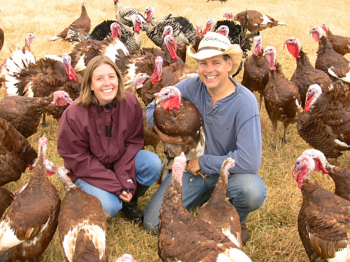 Located in Elberton, Georgia, Nature’s Harmony Farm is a 126-acre diversified meat and dairy farm built by Tim and Liz Young. Raising pasture-based pork, poultry, cattle, sheep, and rabbit, as well as running a grass-fed dairy, the Youngs have taken a holistic approach towards the management of their farm. Tim and Liz examine all of their endeavors with an eye towards long-term biological sustainability. One critical objective of Nature’s Harmony Farm’s holistic planning is breeding disease resistance into their livestock, including Blackhead resistance in turkeys. Located in Elberton, Georgia, Nature’s Harmony Farm is a 126-acre diversified meat and dairy farm built by Tim and Liz Young. Raising pasture-based pork, poultry, cattle, sheep, and rabbit, as well as running a grass-fed dairy, the Youngs have taken a holistic approach towards the management of their farm. Tim and Liz examine all of their endeavors with an eye towards long-term biological sustainability. One critical objective of Nature’s Harmony Farm’s holistic planning is breeding disease resistance into their livestock, including Blackhead resistance in turkeys.
“Now that we’re breeding our own animals on the farm,” says Tim, “we worry a lot less about disease mortality problems. We had such huge issues with pastured poultry two years ago with Blackhead, sinusitis, mycoplasm, etc., which we either don’t see any more or see drastically less of. Our birds look so healthy now, but just a few years ago, we had depressing mortality rates among birds that were shipped in from commercial hatcheries. We’d have experts come out, and they’d say ‘Just burn your entire flock and start all over again.’ We said no, we’re going to build resistance to Blackhead, and all the other diseases. We raise turkeys with our chickens, we don’t worry about any of these things, and we just let nature sort it out.” Liz adds, “We find the strongest birds, those are the ones we breed and their offspring have proven to be so much hardier than all the other animals on the farm. It will take a number of years to get where we want to be, but the results so far give us a lot of hope.” “This was a huge, calculated risk we took as new farmers a couple of years ago,” Tim acknowledges, “but we were so convicted in our values that we felt it was the right thing to do, even though it was counter to all the advice. We’re really happy with the decisions we made back then, and with the health of the birds we have today.” |
Conclusion
Blackhead is a serious disease in poultry that has affected poultry farmers in the United States for well over a century. Turkeys and peafowl are highly susceptible to death from the disease. Chickens are excellent carriers of Blackhead, and care must be taken to keep chickens and turkeys separate. There is no treatment for Blackhead, and so the best strategy is prevention.
References
Davidson, W.R. and G.L. Doster. 2010 (viewed). Blackhead Does Not Cause Blackhead. National Wild Turkey Federation. Bulletin 25.
Hu, J., L. Fuller and L.R. McDougald. 2004. Infection of Turkeys with Histomonas meleagridis by the Cloacal Drop Method. Avian Diseases. Vol. 48, p. 746-750.
Lund, E.E. and A.M. Chute. 1972. Reciprocal Responses of Eight Species of Galliform Birds and Three Parasites: Heterakis gallinarum, Histomonas meleagridis, and Parahistomonas wenrichi. Journal of Parasitology. Volume 58, p. 940-945.
McDougald, L.R. 2005. Blackhead Disease (Histomoniasis) in Poultry: A Critical Review. Avian Diseases. Vol. 49, p. 462–476.
McDougald, L.R. and L. Fuller. 2005. Blackhead Disease in Turkeys: Direct Transmission of Histomonas meleagridis from Bird to Bird in a Laboratory Model. Avian Diseases. Vol. 49, p. 328–331.
Parasite Management for Natural and Organic Poultry: Blackhead in Turkeys
By Terrell Spencer, NCAT Agriculture Specialist
Published November 2010
© NCAT
IP372
Slot 370
Version 111510
This publication is produced by the National Center for Appropriate Technology through the ATTRA Sustainable Agriculture program, under a cooperative agreement with USDA Rural Development. ATTRA.NCAT.ORG.

